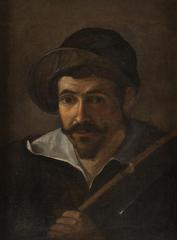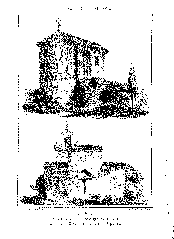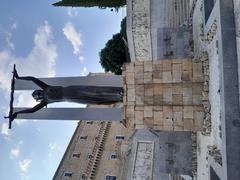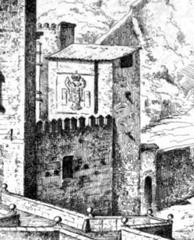Comprehensive Guide to Visiting Presidencia de Castilla-La Mancha, Toledo, Spain
Date: 01/08/2024
Introduction
Toledo, Spain, is a captivating destination known for its rich history, architectural marvels, and cultural heritage. Located on the right bank of the Tagus River, Toledo has been a significant military, administrative, and cultural hub for over 2,000 years. The city’s history spans from its origins as a Roman municipium to becoming the capital of the Visigothic Kingdom and later a major city in Al-Andalus. This multicultural heritage, influenced by the coexistence of Christians, Muslims, and Jews, has earned Toledo the nickname ‘City of Three Cultures’ (Wikipedia). Since 1983, Toledo has also been the capital of the autonomous community of Castilla-La Mancha, further cementing its political and cultural importance in modern Spain (Politics of Toledo). Whether you’re drawn to its medieval streets, historical sites, or local cuisine, visiting Toledo offers a unique journey through time and culture.
Historical Background
Ancient and Medieval History
Toledo boasts a rich history that spans over 2,000 years. Initially, it was a Roman municipium, marking its importance in the Roman Empire. The city’s strategic location on the right bank of the Tagus River made it a significant military and administrative center. Following the fall of the Roman Empire, Toledo became the capital of the Visigothic Kingdom from 542 to 725 CE. This period was marked by the Councils of Toledo, a series of ecclesiastical synods that played a crucial role in shaping the religious and political landscape of the region (Wikipedia).
Islamic Rule and the Reconquista
In the early 8th century, Toledo fell under Islamic rule as part of Al-Andalus. The city flourished as a major cultural and economic hub, benefiting from the coexistence of Christians, Muslims, and Jews. This era left a lasting impact on Toledo’s architecture and culture, evident in its mosques, synagogues, and churches. The city’s multicultural heritage earned it the nickname “City of Three Cultures.”
Visitor Information
Ticket Prices and Opening Hours
Knowing the visiting hours and ticket prices for Toledo’s historical sites can enhance your trip planning. Major attractions like the Toledo Cathedral, Alcázar of Toledo, and the Synagogue of El Tránsito have different schedules and fees. It’s advisable to check their official websites for the most up-to-date information.
Travel Tips
- Best Time to Visit: The best time to visit Toledo is during the spring (March to May) and fall (September to November) when the weather is pleasant.
- Getting Around: Toledo is best explored on foot due to its narrow medieval streets. However, public transportation and taxis are also available.
- Local Cuisine: Don’t miss trying local dishes like marzipan, cochifrito (fried lamb), and carcamusas (pork stew).
Nearby Attractions
- El Greco Museum: Dedicated to the famous painter El Greco, it showcases his works and offers insights into his life.
- Mirador del Valle: A panoramic viewpoint offering breathtaking views of the city.
- Puente de San Martín: A medieval bridge providing picturesque views of the Tagus River.
Accessibility
Toledo is a city with many hills and cobblestone streets, which may pose challenges for visitors with mobility issues. However, many sites offer accessibility options. It’s recommended to check in advance and plan accordingly.
FAQ
What are the visiting hours for Toledo’s historical sites? Visiting hours vary by site. It’s best to check the official websites for the most current information.
How much are tickets to Toledo’s monuments? Ticket prices differ for each monument. Refer to their respective websites for accurate pricing.
Is Toledo accessible for people with mobility issues? While some areas are challenging due to cobblestone streets and hills, many sites offer accessibility options. Planning ahead is advisable.
Conclusion
Toledo, Spain, is a city that offers a rich tapestry of history and culture. From its ancient Roman roots to its vibrant multicultural heritage, there’s something for every traveler. Don’t forget to check the visiting hours, ticket prices, and plan your trip to make the most out of your visit. Follow us on social media or download our app Audiala for more updates and travel tips.
Visiting the Presidencia de Castilla-La Mancha: History, Tickets, and Visitor Tips in Toledo
Historical Context
The Presidencia de Castilla-La Mancha, located in the historic city of Toledo, holds significant historical importance. Toledo has been a pivotal city in Spain’s history, serving as a Roman municipium, the capital of the Visigothic Kingdom, and a major city in Al-Andalus and the Kingdom of Castile. The city’s rich cultural heritage is a product of its diverse historical influences, including Judaism, Christianity, and Islam (History of Toledo).
In the modern era, Toledo’s importance was reaffirmed when it became the capital of the autonomous community of Castilla-La Mancha in 1983. This decision was made after a vote in which it won the support of 22 Spanish Socialist Workers’ Party (PSOE) deputies and five People’s Party (PP) deputies (Politics of Toledo). The establishment of the autonomous community was formalized by the Statute of Autonomy on August 10, 1982 (Castile-La Mancha).
Political Significance
The Presidencia de Castilla-La Mancha is the executive branch of the regional government, headed by the President of the Junta. The President directs the Council of Government and coordinates the functions of its members. The President is elected by the Cortes from among its members and is formally named by the monarch of Spain. The official residence of the President is the Palacio de Fuensalida in Toledo (Castilla-La Mancha).
The Palacio de Fuensalida, a historic building, serves as the presidential office. This palace is not only a symbol of political power but also a testament to the region’s rich architectural heritage. The building itself is an attraction for visitors interested in the political history and architectural beauty of Toledo (Politics of Toledo).
Cultural and Architectural Heritage
Toledo is renowned for its well-preserved medieval architecture, which includes the Alcázar, a fortress that has served various roles throughout history, including as a military academy and a site of significant events during the Spanish Civil War (History of Toledo). The city’s architectural heritage is a blend of Roman, Visigothic, Islamic, and Christian influences, making it a unique destination for history and architecture enthusiasts.
The city is also home to the Santa Iglesia Catedral Primada de Toledo, one of the most stunning cathedrals in Spain. This Gothic cathedral is a must-visit for its intricate architecture and historical significance (Best places to visit in Castile-La Mancha).
Visitor Tips
Best Time to Visit
Toledo can be visited year-round, but the best times to visit are during the spring (April to June) and fall (September to November) when the weather is mild and the city is less crowded. The summer months can be quite hot, and the city sees a surge in tourists, which can make popular sites crowded.
Getting There
Toledo is conveniently located about 30 minutes by train from Madrid, making it an easy day trip from the Spanish capital. The high-speed AVE trains run frequently between Madrid and Toledo, providing a quick and comfortable journey (Toledo - Western Castilla-La Mancha).
Visiting Hours and Tickets
While specific visiting hours and ticket prices for the Presidencia de Castilla-La Mancha are not publicly listed, it is advisable to check with local tourist information centers or the official website of Castilla-La Mancha for the most current information. Guided tours may be available, offering deeper insights into the history and significance of the site.
Key Attractions
- Alcázar of Toledo: This fortress offers panoramic views of the city and houses a military museum.
- Santa Iglesia Catedral Primada de Toledo: A Gothic masterpiece that is one of the most important cathedrals in Spain.
- Synagogue of Santa Maria la Blanca: A beautiful example of Mudéjar architecture, reflecting the city’s Jewish heritage.
- Monastery of San Juan de los Reyes: A stunning monastery built by the Catholic Monarchs, Ferdinand and Isabella (Toledo - Western Castilla-La Mancha).
Cultural Events
Toledo hosts several cultural events throughout the year, including the celebration of Castilla-La Mancha Day on May 31st. This day marks the anniversary of the first regional courts of Castilla-La Mancha, which were constituted in Toledo in 1983. The celebration includes various cultural activities, parades, and public events that highlight the region’s history and cultural heritage (Castilla-La Mancha Day).
Gastronomy
The region of Castilla-La Mancha is famous for its culinary delights, particularly Manchego cheese, a sheep’s cheese made from the milk of Manchega sheep. The region is also a significant wine-producing area, responsible for two-thirds of Spain’s total wine production. Visitors can enjoy local wines and traditional dishes at various restaurants and wineries throughout Toledo (Visit Castilla-La Mancha).
Accommodations
Toledo offers a range of accommodations, from luxury hotels to budget-friendly options. One unique option is staying in a Parador, a luxury hotel located in a converted historic building. The Parador de Toledo offers stunning views of the city and a unique historical ambiance (UNESCO World Heritage Sites in Castilla-La Mancha).
Practical Information
- Language: Spanish is the official language, but English is widely understood in tourist areas.
- Currency: The currency used is the Euro (€).
- Safety: Toledo is generally a safe city for tourists, but it is always advisable to take standard precautions, such as keeping an eye on personal belongings and avoiding poorly lit areas at night.
FAQ
What are the visiting hours for the Presidencia de Castilla-La Mancha? Visiting hours for the Presidencia de Castilla-La Mancha may vary. It is best to check with local tourist information centers or the official website for the most current information.
How much are tickets for the Presidencia de Castilla-La Mancha? Ticket prices for the Presidencia de Castilla-La Mancha are not publicly listed. For the most accurate and up-to-date information, please consult local resources or the official website of Castilla-La Mancha.
Are guided tours available at the Presidencia de Castilla-La Mancha? Guided tours may be available and can offer deeper insights into the history and significance of the site. Check with local tourist information centers or the official website for details.
Conclusion
The Presidencia de Castilla-La Mancha in Toledo is not just a political center but a gateway to exploring the rich history, culture, and architectural heritage of the region. Whether you are interested in history, architecture, or gastronomy, Toledo offers a memorable experience for every visitor. Don’t forget to check out our mobile app Audiala for more travel tips and updates! Stay connected with us on social media for the latest information (The Culture Trip, Guías Viajar).
References
- History of Toledo, Spain Wikipedia
- Politics of Toledo (Spain) Wikipedia
- Castile-La Mancha Britannica
- Best places to visit in Castile-La Mancha aTLifestyleCrossroads
- Toledo - Western Castilla-La Mancha Spain This Way
- Castilla-La Mancha Day Turismo Provincia Toledo
- Visit Castilla-La Mancha Spain This Way
- UNESCO World Heritage Sites in Castilla-La Mancha Spain This Way
- The Culture Trip The Culture Trip
- Guías Viajar Guías Viajar
- Spain Guides Spain Guides
- ConversaSpain ConversaSpain















